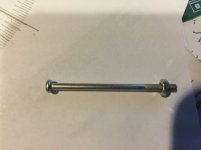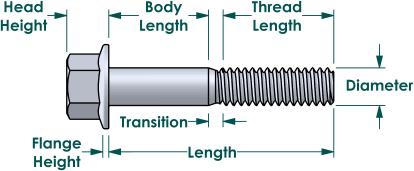Oh, then "shoulder screw".
Why not send your needs to McMaster-Carr, and ask if they can provide it.
Why not send your needs to McMaster-Carr, and ask if they can provide it.
That appears to be an odd head geometry on that one, hopefully you can substitute something like this;
https://www.mcmaster.com/#91770a847/=187a2mv
https://www.mcmaster.com/#91770a847/=187a2mv
thanks Phase.
https://www.mcmaster.com/#machine-screws/=187yc37
but the length need to be 2 inches and then thread size is not matching
https://www.mcmaster.com/#machine-screws/=187yc37
but the length need to be 2 inches and then thread size is not matching
Last edited:
A screw has the threads all the way to the head, but the last 1.5 threads may not be fully formed.
A bolt has a plain shank and then the threaded portion. Again the last 1.5 threads may not be fully formed.
A shouldered screw/bolt has a plain shank that is larger than the screw thread size.
There is a version of this that does not have a pronounced step, between the thread and the shank. I don't know the name for this.
A bolt has a plain shank and then the threaded portion. Again the last 1.5 threads may not be fully formed.
A shouldered screw/bolt has a plain shank that is larger than the screw thread size.
There is a version of this that does not have a pronounced step, between the thread and the shank. I don't know the name for this.
Kinku,
Okay, so you need 2 inch length, with 1/2 inch of thread.
What is the thread size? and count?
Did ya try to ID at any big box store?
I've seen them (one) before, but can't recall on what, to what,
what does it go to?
Take a pic of the head end, on end so we can see what goes
in it to drive it. Many say Phillips when they are the driver
or reed and prince, or the ones from Japan/Asia...JIG, JIP, JIN ? or so.
Okay, so you need 2 inch length, with 1/2 inch of thread.
What is the thread size? and count?
Did ya try to ID at any big box store?
I've seen them (one) before, but can't recall on what, to what,
what does it go to?
Take a pic of the head end, on end so we can see what goes
in it to drive it. Many say Phillips when they are the driver
or reed and prince, or the ones from Japan/Asia...JIG, JIP, JIN ? or so.
A shouldered screw/bolt has a plain shank that is larger than the screw thread size.
There is a version of this that does not have a pronounced step, between the thread and the shank. I don't know the name for this.
Andrew are you referring to something like Cosworth Engine type bolt?
or
A socket head cap screw that has a small fillet radius?
The 1 to 2 ending threads typically called thread runout.
On very high quality bolts/screws that are mounted in
tension, we'll find a smaller diameter shank which has less of
a change of breakage.
If the blot/screw is mounted in double sheer (aircraft for example)
you don't want to use them with smaller diameter shanks....the load
is cross wise to the fastener.
Finally, we want rolled, not cut threads.

That smiley is a requirement of my little four year old.
Cheers
could be. There are many specialied bolts that are turned down where there is pure tension that maintain full diameter where a joint places shear on the bolt shank.Andrew are you referring to something like Cosworth Engine type bolt?
I think this is more for weight saving..............
tension, we'll find a smaller diameter shank which has less of
a change of breakage.
I kept as a souvenir a rolled thread socket head cap screw that must have got misaligned between the rollers and ended up with a double helix instead of a single thread. Somehow it got passed by QA.If the blot/screw is mounted in double sheer (aircraft for example)
you don't want to use them with smaller diameter shanks....the load
is cross wise to the fastener.
Finally, we want rolled, not cut threads.........
It resembles the straight spokes BMW used in the wheels of their very last airhead twins. But I suspect the depicted screw might not be long enough for this duty.
Best regards!
Best regards!
Last edited:
- Status
- Not open for further replies.
- Home
- Design & Build
- Parts
- Screw type

